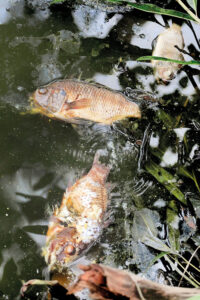
Ecological and Environmental concerns must be addressed
Sri Lanka has the advantage of a unique bio-diversity footprint and ecological advantages yet over time, as a result of short-term goals that border on fast gains, the eco balance has shifted, causing considerable harm to the environment around us, Prime Minister said in a message to mark International Environment Day.
The Prime Minister’s Message adds: “We need to rediscover the manner in which our ancestors were able to co-exist in harmony with nature; as a country, every-one of us must be conscious of the need to address ecological and environmental concerns as we travel the path to progress. It is the challenge that faces every individual and the Government in achieving an optimum balance between development and managing the environment the right way.
“If we do not pay adequate attention to the eco systems and address environmental erosion, needless to say that there would be drastic consequences which the world has witnessed time and again.
“As we celebrate the International Environment Day, we must come together as a nation to rediscover the respect and the consideration for nature, while inculcating a wider consciousness of the environment in everyone.”
Source – 05/06/2017, Ceylon Today , See more at – http://www.ceylontoday.lk/print20170401CT20170630.php?id=22567
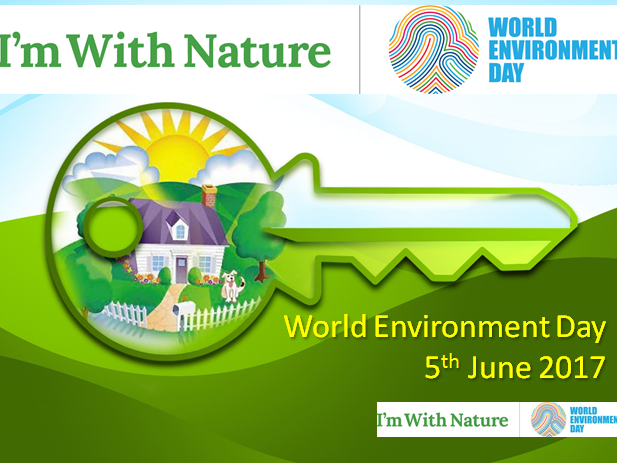
Why everyday should be World Environment Day
In the first 6 months of this year, Sri Lanka has experienced a number of major events that demonstrate exactly how critical managing the environment is: Drought, landslides, a garbage avalanche, flash floods — and many other events at scales that have not caught the attention of those not affected. The damage to lives and assets, and the disruption to routines that make us who we are psychologically and spiritually is tough to live through and slow to reverse – if it ever does.
By Idah Pswarayi-Riddihough
So why would we leave thoughts on sustainable environmental management to just one single day a year? We typically celebrate “Environment Day” by picking up rubbish around the city or from the rivers, or the sea; or by participating in a charity walk, or a charity run, and so forth. The excitement builds, everyone engages and the next day everyone moves on to “more pressing matters” until the next calamity, and the blame game starts all over again.
Let me assert the following key point: Nothing will change until we all see ourselves as part of the problem and part of the solution. For many of these issues we can make a difference, every day!
Let’s talk trash. We all of us generate rubbish at a private level, in our homes. Once we haul the garbage bags out it no longer exists as far as we are concerned. In fact, it becomes a public issue. If we were to make the simple commitment to segregate our waste inside the home between biodegradable, recyclables, and residual waste, and if it was collected honoring these waste streams, and disposed of correctly, overall waste would be significantly reduced. Even better, compost can be used to fertilize crops and gardens.
What about the rubbish that we throw away casually as we travel? It ends up in drainage systems, blocking them and exacerbating flooding and sewage releases; or disfiguring a country that rightfully prides itself on its beauty; in the seas and oceans where it degrades those environments too. Should we really wait until Environment Day each time to then go and collect our rubbish?
I would like to challenge every one of us to turn the inertia that sets in after Environment Day into action.
Here is my proposal.
Let’s support and challenge the Government to facilitate and strengthen environmental regulatory and policy-making. Let’s encourage them to invest in the infrastructure that supports on-going efforts to safeguard our environment; be it sanitary land-fills; small-scale irrigation schemes and reservoirs to stem droughts and store water for a dry day; and better regulation of biodiversity use, for example. The private sector must step forward and bring their experience and financing to help the Government fund these investments. Experiences from other countries show that there are parts of the waste management value chain that are sufficiently robust to return profits to financiers. Schools must teach children better environmental awareness — children will carry these habits to adulthood. While it’s important that NGOs retain their ability to contest what they see as wrong, it’s also important that they come closer to the Government to help develop and implement solutions. Solving these issues may come with some discomfort. The Government will have to place infrastructure in someone’s neighborhood – one of the penalties of a fast growing economy where land is at a premium. People may also need to be moved away from potential harm. And, development partners may need to take up new areas of investments.
Ultimately, there is need for clarity on what roles we — the public, the Government, the private sector, NGOs — can play to contribute to this complex agenda. We all must engage, though. If we let the environment become degraded, the local and global effects will be detrimental and very long lasting. These problems could considerably reduce opportunities for future generations, as the impacts will affect economic growth, the safety of our hard earned assets, and even our life expectancies.
The environment does not remind us of its importance once a year; it does so daily. I yearn for a day when the most important news is not who dropped the ball, but how much — as a collective — we have achieved to better our environment; reducing loss of life, increasing the quality of life, and creating an environment that we are proud to leave for our children and their children.
This, will only happen if every day is Environment Day! Happy World Environment Day
Ms. Idah Pswarayi-Riddihough is the Country Director for Sri Lanka and the Maldives in the South Asia Region (SAR).
Ms. Pswarayi-Riddihough, a Zimbabwean national, joined the Bank in 1995 as a Young Professional (YP). She earned her PHD from Oxford University in 1993. She has since held various operational and corporate management positions, her most recent being Director of Strategy and Operations, in the Human Resources Vice Presidency. She has worked in 4 different regions, South Asia, East Asia, Middle East and North and Africa and the Africa Region. Her most recent posting in South Asia was as the Director of Operational Services from 2012 to 2014, where she also supervised teams covering operations in Financial Management and Procurement.
Source – 05/06/2017,Times Online, see more at – http://www.sundaytimes.lk/article/1023262/why-everyday-should-be-world-environment-day
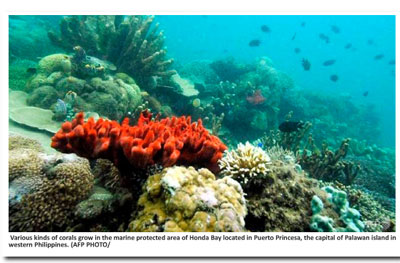
UN talks to save oceans kick off

World leaders convened at UN headquarters yesterday for the first major bid to solve the toughest problems facing our oceans, from coral bleaching to plastic pollution, overfishing and rising seas due to climate change.
The Ocean Conference in New York June 5-9 is to rally nations big and small to make meaningful changes to preserve what is arguably the Earth’s most important resource, experts say.
US President Donald Trump’s recent decision to withdraw from the Paris climate accord is anticipated to be a hot topic at the talks, which no high-ranking US officials are expected to attend.
But despite Trump’s decision Thursday to end US participation in the Paris deal, which drew worldwide condemnation, experts at the Pew Charitable Trust said the United States has been a part of crafting a broad “call to action,” and is expected to sign it.
“We are committed to halting and reversing the decline in the health and productivity of our ocean,” says the three-page document, which also expresses alarm at the impact of climate change on the ocean.
The call to action is expected to be signed and released at some point during the week-long conference, which will bring government officials, ocean advocates and some heads of state to New York.
The US pullout from Paris means other nations will lead the way at the UN talks, particularly small island nations that have the most to lose from rising seas.
“How can you worry about someone who is not in the room?” said Ambassador Ronny Jumeau, permanent representative to the United Nations for the Seychelles islands.
“Look at who is here, who is sitting in the front row, and say, ‘Now what are we going to do about this?’”
The world just marked its three hottest years in modern times. And the oceans have absorbed about one third of the carbon dioxide released by human activities, protecting the planet from the full brunt of climate change.
Melting glaciers and sea ice at the poles threatens swell sea level to the point of washing away entire islands and populated coastlines — home to 37 percent of the planet’s population — in the coming decades.
Just 20 inches (half meter) of sea level rise could displace 1.2 million people from islands in the Caribbean Sea, Indian and Pacific Oceans.
Recent studies have shown the troubling extent of plastic pollution, even in the most remote parts of the world.
An uninhabited island in the south Pacific, Henderson Island, thousands of miles from civilization was recently shown to be piling up more than 3,500 pieces of plastic per day.
Every year, more than eight million tons of plastic washes into the oceans, costing at least $8 billion in damage to marine ecosystems and killing an estimated one million sea birds, 100,000 sea mammals and untold numbers of fish.
And famous coral reefs, such as Australia’s Great Barrier Reef, are suffering from hot temperatures like never before in modern times, with mass bleaching and die-offs continuing unabated for the past two years.
“Small island states cannot afford to be dismayed or feel down or depressed about any of this,” said Jumeau during a UN press conference.
“We are reaching out to all the friends of the oceans that you can think of to meet the challenges that we face.”
Previous global meetings on problems facing the oceans have taken place, but the World Wildlife Fund’s John Tanzer described this one as “historic” because the talks are under the auspices of the United Nations for the first time.
“The reality is that oceans have been in steep decline for at least the last 50 or 60 years,” Tanzer, global oceans lead at WWF, told AFP.
“Here we are in 2017, and it is impossible to talk of anywhere in the world’s oceans as being pristine,” he said.
Specifically, nations will talk about how to meet the 2015 UN-adopted Sustainable Development Goal 14, to “conserve and sustainably use the oceans, seas, and marine resources.”
Targets include protecting at least 10 percent of coastal and marine environments by 2020, reducing ocean pollution and strengthening ways to fight illegal, unreported and unregulated fishing.
A recent report found that illegal fishing in the Pacific has reached a “staggering” value of up to $740 million a year, with much of the problem blamed on fleets from the US, Asia and Europe that under-report their catches.
Individual nations and advocacy groups are already announcing voluntary steps they will take to conserve oceans and protect marine life.
Source – 06/06/2017, The Island Nation, See more at – http://www.island.lk/index.php?page_cat=article-details&page=article-details&code_title=166268
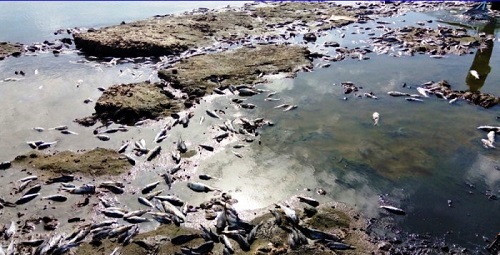
Hundreds of dead fish seen floating along Mullaitivu coastline

Recently hundreds of dead fish were seen floating along the shoreline in the seas of Mullaitivu. Captured here are images taken by our correspondent.
Fishermen in the area were puzzled as to what caused hundreds of dead fish to congregate on its shores, investigations are still underway to ascertain the cause.
Source – 06/06/2017, Times Online, see more at – http://www.sundaytimes.lk/article/1023255/hundreds-of-dead-fish-seen-float-along-mullaitivu-coastline

From Pinnawala’s freedom to shackles in somebody’s backyard
Within the span of 40 years of the Pinnawela Elephant Orphanage, the baby born on the eve of 2nd July 2015 was the 70th. He was born to parents Shanthi and Wasabha under the observation of veterinarians as a very healthy young one. As this was the first birth recorded after 2010 it was an immensely joyous occasion to the whole of the staff. On the auspicious day of 06.08.2015 the baby was named “Anuradha” and was released to the herd of elephants. The greeting he and the mother received was a heartfelt sight bringing tears to the eyes of tourists and workers alike. As Anuradha and Shanthi neared the herd Anuradha’s aunt Meena came forward to escort them towards the middle. There the matriarch greeted them and welcomed to the herd with customary trumpeting. Then the whole herd huddled to a single pile touching and cuddling their newest precious member with promises of taking care of him well.” – As announced in the Department of National Zoological Gardens website.
Now we hear of a Cabinet decision to give elephants from the Pinnawela Elephant Orphanage (PEO) to individuals and institutions– a move that will cruelly separate elephants from their close knit herds. That the PEO is overcrowded is the reason for this decision. Individuals will have to pay a Rs. 10 million bond, but the bond will not apply to religious institutions.
Conceptualised by then Tourism Minister P.B.G. Kalugalle, the PEO established in 1975, stands on 25 acres of land, on the banks of Ma Oya, amidst the scenic beauty of luxuriant verdancy. Originally under the Wildlife Conservation Department, it is now under the National Zoological Gardens Department (NZG). Today, home to 88 elephants, it opened with five orphaned elephants.The first calf born there, in 1984, was Sukumali. A prime tourist attraction, the PEO is one of the State’s main revenue earners.
For animal rights activists and conservationists, the Cabinet decision is distressing. It is heartless and ill-conceived – exposing these magnificent animals to cruelty, abuse and exploitation and affecting their breeding.
Elephants are herd animals. They live in matriarchal family groups, led by the oldest female in each herd. Elephant behaviourists say elephants display complex social and emotional behaviour, valuing their families more than most animals and form lifelong friendships among them, even mourning the deaths of loved ones, with mothers grieving over stillborn calves and some lingering where friends and family members had died. The calves sometimes hold on to their mother’s tails with their trunks to keep up, while other female elephants protect them from danger. Being extremely intelligent animals, with long memory spans, said to serve matriarchs well when during dry seasons they guide the herd to watering holes, over long distances they recall from the past. In private custody, deprived of their natural habitat, where they roamed free with their herd, browsing, foraging and socializing, these majestic animals undergo tremendous physical and mental suffering.
Instances of elephants given to private individuals and temples, suffering or dying due to cruelty, negligence, lack of care or callousness are galore. There are photographic evidence and eye witness accounts – all four feet shackled for hours with short iron chains cutting into the skin causing deep wounds, and fatal foot ailments due to lack of exercise. Assaults by intoxicated mahouts, exposure to lightning and floods causing death, torturous training, using heated iron rods for taming, parading on burning concrete roads, malnutrition, lack of veterinary care, starvation during pageants, overriding, overdriving and pulling by the ears to hasten speed at elephant races popular at Sinhala New Year festivals are only a few examples of this wanton cruelty.
Sannasas or agreements giving elephants to private custody require the animals to be used only for religious or cultural activities, but they are often hired for commercial gain by the recipients to hotels for rides or to nature parks. As Wildlife Minister Gamini Jayawickreme Perera has said, “When we announced that we are going to take back elephants if we find them used for elephant rides almost 80 % of the temples had taken back their elephants, admitting that the temples were engaging in tourism activities.”
There are no laws to assure captive elephant welfare. Consequent to a court case filed by the Animal Welfare Trust, Welfare Regulations were formulated, but a delay in their gazetting to give them the force of law has led to concerns that persons with vested interests are stalling them. The Wildlife Minister however, has given clear directions to his officials to take immediate action to gazette them.
Captive breeding statistics are dismal, with only three births recorded.Pinnawela,by 2015 had 70. Former NZG Director General Brigadier H.A.N.T. Perera says, private owners are disinterested in breeding, as pregnant elephants, during their 22 month long gestation period,cannot be used to earn money.
Challenging the statement that there is overcrowding, some speculate that the Cabinet decision is a stratagem to give elephants to those demanding them complaining that they have no elephants for peraheras, but mostly requiring them 24×7 to exploit for commercial purposes. The creation of a ‘pool’ of trained elephants in Pinnawela to ‘hire’ for peraheras and return, a move unreservedly endorsed by activists, has been considered previously, but without success. Such endorsement exposes the humbug of those accusing activists of conspiring to destroy religion and culture by opposing private ownership. According to Brigadier Perera,then Environment Ministers Rukman Senanayake and A.H.M. Fowzie had between 2001 and 2004 sought Cabinet approval to train and hire out 50 elephants from the PEO, but with the Cabinet suggesting changes, which were not pursued, it had died a natural death. Last year, incumbent Minister Perera too made a similar recommendation.
As Brigadier Perera says even now the Pinnawela Zoo can be used not only to expand the PEO, but also to establish a Training Centre, a Veterinary Hospital and other facilities making it a Regional Centre of Excellence for Asian Elephant Conservation. Another option is to acquire adjoining land. Cannot land expansion be pursued to resolve Pinnawela’s purported overcrowding instead of separating elephants from their families?
President Maithripala Sirisena pledged a compassionate government in his Manifesto, referring also to the need to prevent violence to animals. A compassionate government cannot have heartless decision makers,who for political gain, succumb to the demands of those who will abuse animals for monetary gain. This compassion should apply not only to people, but also to elephants and all other animals.
Source – 04/06/2017, The Sunday Times, See more at – http://www.sundaytimes.lk/170604/plus/from-pinnawalas-freedom-to-shackles-in-somebodys-backyard-243034.html
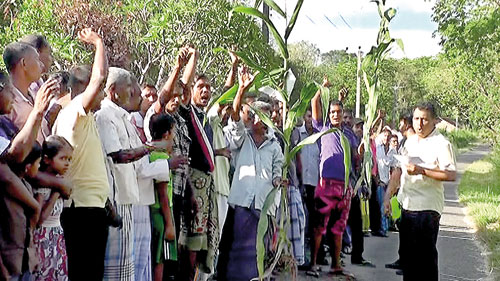
Environmentalists and academics bitter-sweet on sugar cane cultivation in Bibile
By Chrishanthi Christopher
The Government plan to launch a sugar company in Bibile has drawn protests from environmentalists who say that, the cultivation of sugarcane will use up the ground water, depriving people of their source of legitimate drinking water. A Cabinet paper has reportedly been passed for the project due to commence in early December. Under the project, plans are under way to distribute 62,500 acres of land to 10,000 farmers in the Uva-Wellassa region, to cultivate sugarcane in the area.

Residents hold a protest
Under the scheme, each farmer will get 2.5 hectares of land to cultivate sugarcane. It is claimed the project will eliminate poverty among farmers in the area. The Centre for Environment and Nature Studies claimed the Govt has given a human face to the project, following massive protests encountered in the past. Convener Raveendra Kariyawasam said an earlier attempt in 2006, by the then Govt to hand over the sugarcane project to Britain’s Booker Tate, was foiled by protesting people.
The farmers are expected to cultivate the land and sell the produce to the company. The land will be leased to the farmers, while farmers opting to withdraw from the project will have to return the land to the Govt. The company will be given only 149 acres of land on which to operate. Environmentalists fear that the cultivation of sugarcane will use up the ground water used by the area residents for drinking, as they claim that, sugarcane cultivation needs plenty of water hence, depleting the Uva-Wellessa water table.
Professor B. Marambe of the Peradeniya University’s, Agriculture Dept, said the crop does not use up ground water for growth. “Sugarcane belongs to the grass family, just like rice, maize and sorghum and, unlike rice, grows well in the highlands. Rice, on the other hand, is extensively cultivated in the lowlands and uses up plenty of water, while sugarcane, comparatively, uses less water,” he said. The Professor, who has done extensive research on sugarcane said the crop takes 9 to 12 months to yield, and needs continuous and adequate water right through the year and, because of its longer duration to yield, may use up more water. But, as the root system is fibrous, it cannot reach down to the ground water.
Further he discounted the argument that many sugar producing companies in the world are moving away from sugarcane cultivation because of the drain on ground water tables in those areas.
“They are moving out because of the agricultural chemicals used to kill the weeds in sugarcane cultivation,” he said. He maintains that, if a bi-annual crop is cultivated on the same land, the water usage will be very much higher. “It is only speculation that the water table will be exhausted. Sugarcane belongs to the C4 category of plants and uses up less water than the C3 category- maize and paddy plants.”
“In Moneragala, the ground water table is deep and the volume of water underground fluctuates according to the rainfall received in those areas,” he said.
Meanwhile, Director-CEO of the Sugar Research Institute, Dr A.P. Keerthipala also dismissed the argument that ground water will be depleted. “There is no scientific evidence to prove this,” he said.
“There is always opposition when a new project comes up. This project is designed to uplift the economic levels of the poor farmers who can earn up to Rs 250,000 a year. In addition, there will be several infrastructure developments which the residents of the area can enjoy,” he said. “Also, there are several other upcoming projects in Batticaloa, Maduru Oya and in the North,” he said.
Source – 04/06/2017,The Sunday Times, See more at – http://www.sundaytimes.lk/170604/news/environmentalists-and-academics-bitter-sweet-on-sugar-cane-cultivation-in-bibile-243445.html
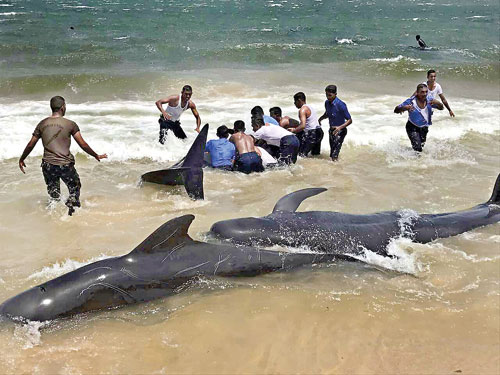
Sampur pilot whales stranding will remain a mystery View(s): 132
A pod of about 20 pilot whales stranded on Sampur beach in Trincomalee were pushed back to sea last Wednesday by some navymen and locals.
Marine mammal expert Ranil Nanayakkara, identified them as short-finned pilot whales (Globicephala macrorhynchus).
While this is rare in Sri Lanka, there have been occasions elsewhere when pilot whales have run aground.
Mr Nanayakkara points out that in February more than 400 pilot whales washed up on a New Zealand beach.
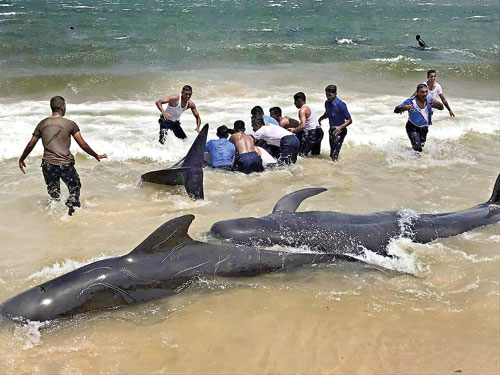
The pod of about 20 pilot whales stranded on Sampur beach in Trincomalee
Beached whales die due to dehydration, or drowning when high tide covers the blowhole. In some cases, they die by collapsing under their own weight.
Available literature indicates that about 10 species of whales – mostly toothed whales are more prone to being stranded than others.
Why whales get beached in an apparent suicide mission remains a mystery. Many whales use echolocation to navigate, so one theory is that man-made sonar in ships etc. may be interfering with whales and/or natural brain wave activity causing them to become disoriented. Seismic activities on the ocean floor too could be contributory factor.
Most of the whales have close-knit family units, so another hypothesis is that a pod of whales can accidentally become stranded when attempting to come to the aid of a beached whale that is sending out distress calls.
A pilot whale pod can be made up of 20 to 50 individuals, but large super pods with hundreds of individuals too are frequent. They are primarily matrilineal or a female-based society with strong family bonds, so if one swims on to the beach, the others could follow. They have an acute sense of hearing according to marine researchers, making them more prone to stranding. In 1918, over 1,000 pilot whales got beached in New Zealand.
Although the pilot whale’s behaviour resembles that of larger whale species, it belongs to the oceanic dolphin family. Pilot whales are large, robust animals with a bulbous head and no discernible beak. They are black in colour. A male pilot whale can grow up to 5.5 metres (18 ft) in length, whereas adult females are about 3.7 metres (12 ft) in length.
The short-finned pilot whale primarily feeds on squid while certain species of fish and octopus too are included in their diet. They dive deep 300 metres (1000 ft) deep or more in search of prey and spend great lengths of time at depth. Pilot whales are also known as the ‘cheetas of the deep’ for their ability of high speed pursuit of prey deep in the ocean.
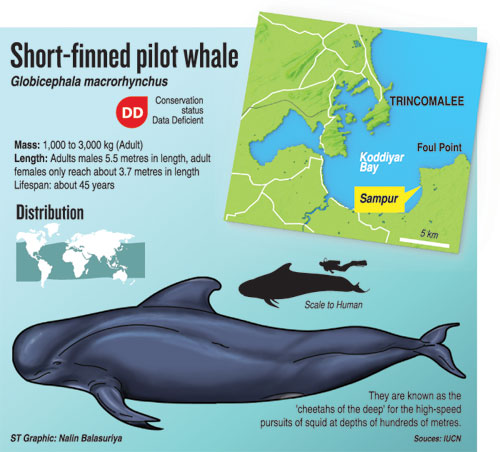
Source – 04 /06/2017, The Sunday Times, See more at – http://www.sundaytimes.lk/170604/news/sampur-pilot-whales-stranding-will-remain-a-mystery-243484.html
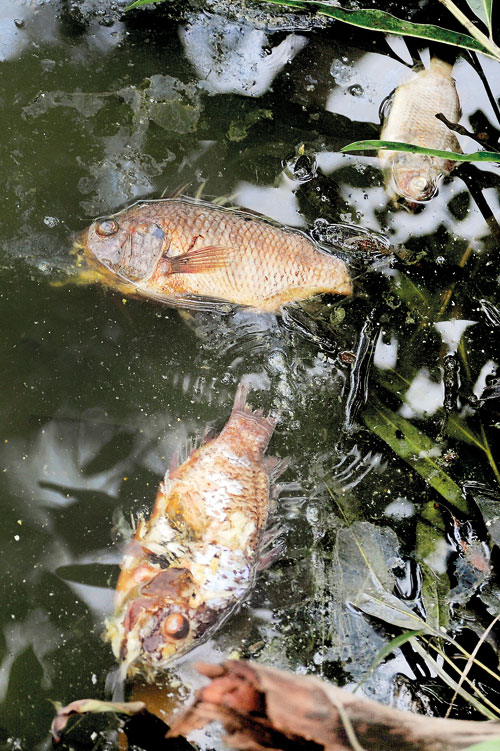
Muthurajawela becoming environmental wasteland
Dead Fish
Thousands of fish farmed for consumption have been found dead at Bopitiya, Muthurajawela after heavy rains and the flooding contaminated the farms with waste from large scale piggeries, factories, and the recently dumped garbage. The people who ran the fish farms say the fish were dead within days when dark oily water contaminated their tanks.
The Sunday Times journalists witnessed the dead and blackened fish that floated on the surface of the water.
One fish farmer, Sarath Saparamadu, estimated his losses at Rs 150,000. He is also the treasurer of the Pamunugama Jala Jeewi Wagakaruwange Sangamaya.
He explained that the fish farmers specialised in thilapia, which they sell to hotels. “I was hoping to collect the catch within two months, but lost everything. Usually I collect over 20 metric tonnes,’’ he said.
The villagers in the area said that Muthurajawela can no longer be called a marsh because of the farms, steel factories, and garbage dump sites.
Mr Saparamadu said that the public health inspector and Grama Sevaka had only visited his residence at Madawatta, Muthurajawela once. The official did not even collect water samples.
Fish farmer, Rukman Chandrasena, said he had once witnessed the deaths of fish earlier, when waste from a large scale pig farm contaminated the water. He had complained to the PHI, the Grama Sevaka, and the Pamunugama Police at the time, but it was futile.
Once again, he complained of the damage, a week ago, he said. But no one is taking responsibility and there is no compensation.
He said that most fish farmers use water from the Hamilton Canal and other small waterways which are connected to the Muthurajawela lagoon. He said the fish in the canal have disappeared.
“Our tanks fill up with contaminated water during high tide and flush out. In my seven tanks, 15,000 fish are under threat. Already three tanks have been affected,’’ he said.
After many complaints, the PHI and the Grama Sevaka visited the area but nothing was done.
Meanwhile, the president of the Pamunugama Jala Jeewi Wagakaruwange Sangamaya, N.T.A Perera, said that he lost between 12,000 and 20,000 fish.
He said the fingerlings died quickly. Only one tank out of four holding fingerlings remained unaffected.
Three fish farmers in Bopitiya, including himself, were affected, while 22 members of the group, operating in other areas, escaped the damage.
“Owners of the pig farm release waste into the water during the rainy season while factories also pump toxic waste into the water,” he said.
Anil Lankapura Jayamaha, the president of the Organisation for Protecting Muthurajawela Sanctuary, said he had predicted such incidents following garbage dumping in Muthurajawela.
The Bopitiya Police, Govijana Seva Centre, and the Wild Life Department are ignoring the environmental degradation, he said.
Mr Jayamaha said that the people also filed a fundamental rights case against the destruction of the environment.
He charged that supporters of the previous lands minister and other powerful people are filling up sites illegally.
A senior official of the Wattala Divisional Secretariat, said that the government is causing massive damage to Muthurajawela by dumping garbage there.
The PHI of Bopitiya S R K Indunil Samaratunga declined to comment when contacted.
Meanwhile, the Sunday Times has learned that trucks are dumping unsegregated garbage on the Bopitiya gas plant site.
The Colombo Municipal Commissioner V K Anura claimed that only segregated garbage is dumped at Bopitiya. Meat or fish waste are not taken to the site, he said.
He said local government bodiesfrom other areas dump unsegregated garbage on the site. “Our garbage dumping is done smoothly. There are no issues regarding [our] garbage,’’ he claimed.
But Colombo Municipal Council garbage truck drivers said the garbage is not sorted.
Sometimes they are not allowed to dump garbage at Bopitiya because it had not been separated, or because it exceeded the daily limits, they said.
“Our overtime allowance is cut if we dump unsegregated garbage,” they said.
They said senior officials keep changing their plans about garbage collection.
“We used to only collect separated garbage on some days and unsegregated garbage on other days. Now people give us all the garbage, unseparated. So we are compelled to dump it (in Bopitiya),” the truck drivers said.
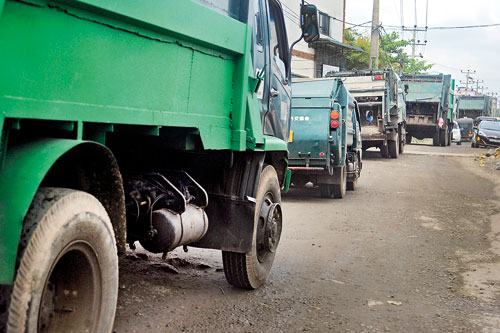
Trucks returning to Colombo after dumping unsegregated garbage at the site of the Bopitiya gas plant

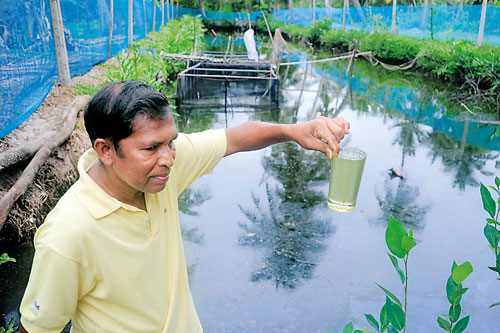
Sarath Saparamadu: Estimates his losses at Rs 150,000. Pix by Amila Gamage
Source – 04/06/2017, The Sunday Times, See more at – http://www.sundaytimes.lk/170604/news/muthurajawela-becoming-environmental-wasteland-243476.html

Yala National Park a mess due to political meddling
Give DWC independence to do its job, urges former DG
Tourism officials conspicuous absentees at biodiversity event
By Kumudini Hettiarachchi
Everyone else was there, except the tourism officials. Even though numerous invites had gone out to a wide-range of tourism officials, no one deemed it important to grace the discussions on ‘Biodiversity & Sustainable Tourism’ vital for people’s existence, held on May 22. This was what the participants at the event organised by Biodiversity Sri Lanka (BSL) on International Day for Biological Diversity held at the HNB auditorium in Colombo heard after queries were raised whether any tourism officials were present.

The panellists (from left) Dilhan Bandara from Tangalle’s Anantara Hotel, Madura de Silva of the Wildlife Conservation Society, Galle, Maeve Nightingale from the International Union for Conservation of Nature (IUCN) and Dr. Sumith Pilapitiya, former Director-General of the Department of Wildlife Conservation.
Four panellists dealt with the crucial topics of ‘Challenges in the Yala National Park (NP)’; ‘Vistas of Sinharaja’; ‘Dollars for deeds’; and ‘Significance of the coasts around us’, after which there was a robust discussion moderated by BSL Advisor Shiranee Yasaratne.
Tackling over-visitation and its consequences on the biodiversity of the Yala NP, former Director-General (DG) of the Department of Wildlife Conservation (DWC), Dr. Sumith Pilapitiya, questioned whether a natural ecosystem can sustain “abuse” in the light of tourist numbers skyrocketing more than 1,000% from 2008 to 2015 – from 48,368 to 545,007 visitors at Yala.
Explaining that no formal studies have been done whether over-visitation has adverse impacts on biodiversity, he pointed out that road-kills have increased within the Yala NP, there is harassment of wildlife at sightings, visitors are feeding wild animals and causing behavioural changes in them and there is anecdotal evidence of a decline in the animal population within Yala.
He was very critical of the government’s “over-emphasis” on tourism revenue, while neglecting protection and management of Protected Areas. Dr. Pilapitiya not only zeroed-in on the problems but also provided answers on how to overcome them. According to him the approach should be the identification of the issues that need to be addressed and the constraints in dealing with them; and studying the profile of tourists using Block 1 of the Yala NP where there are huge issues, while introducing a strategy to improve overall visitor experience there.
“The nature-interpretation services offered by the DWC are poor,” he said, adding that the DWC also faces a dearth of staff and facilities such as patrol vehicles to regulate tourism within the NP. The DWC is challenged by inadequate guide numbers, inability to get government approval for more recruitment, weak enforcement of NP rules and lack of independence to penalize violators.
While there are nearly 700 registered commercial safari vehicles, the issues to be addressed include the indiscipline of safari jeep drivers and passengers whenever there are animal sightings, high speed and reckless driving when attempting to reach such sightings and massive vehicle jams and disturbance of wildlife during sightings.
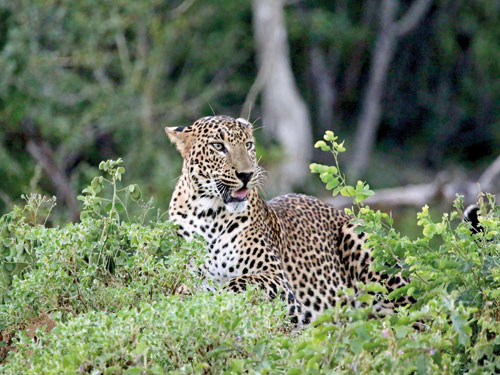
“If there is one paradise for leopards on earth, it has to be Yala National Park,” had said award-winning wildlife photographer Angela Scott but have Yala’s leopards been over-marketed?
The former DWC Director-General who resigned due to political interference preventing him from performing his duties, pointed without ambiguity, at “continued political interference” in the wake of which follows lack of independence for the DWC to regulate tourism within Yala. “There is uneven imposition of rules due to political patronage and interference.”
He also added that while Yala’s Block 1 faced much over-visitation, the wildlife in Blocks 3, 4 and 5 were not habituated to visitor-vehicles. Profiling the current ‘visitors’ to Yala, he said they are focusing on “sightings” and not “observations”, with the NP at present being marketed as a “leopard-sighting location”. Therefore, the short-term strategy for the conversion of Yala into a “wildlife observation site” is impractical.
Dr. Pilapitiya turns the spotlight on an implementable ‘Action Plan’ proposed, which includes:
- 31 short-term actions to be implemented by January 1, 2018 — Regular patrolling, strict enforcement of rules, progressively increasing penalties, speed-bumps, uni-flow system where possible, training of both safari jeep drivers and DWC guides and using Blocks 2, 3, 4 and 5 for ‘wilderness’ tourism.
- 9 medium-term actions to be implemented by January 1, 2019 – Zoning the park, opening the west-side of the Sithulpauwwa Road, a carrying-capacity assessment and halting the over-promotion of Yala by the tourism industry.
- 2 long-term actions by 2023 – With increased sightings in Blocks 3, 4 and 5, imposition of vehicle limits in all blocks through gradual reductions and empowerment of DWC officials.
Dr. Pilapitiya is adamant that DWC officials “must” be empowered to enforce regulations without being fearful of a political backlash. “For this, the responsibility clearly lies with the highest-level political authorities and the Wildlife Minister.”
Referring to the coast around us, it is Maeve Nightingale of the International Union for Conservation of Nature (IUCN) who details marine and coastal tourism that Sri Lanka can engage in, however, stressing that there is a fine balance between conceptual issues and constraints to sustainable tourism, when taking into account the environment (natural habitats and local livelihoods) on one hand and financial criteria (infrastructural development, tourist arrivals and tourism products and services) on the other.
She pointed out that tourism as a whole is the most international “trade” item with reef tourism becoming an increasingly large component. However, the adverse impacts of reef-based tourism could be immense.
Citing the example of the small island of Koh Tao in the Gulf of Thailand, Ms. Nightingale said that it has one of the largest dive industries in the world with over 65 dive schools and operators. It is also accountable for one-third of the annual registrations of the Professional Associations of Dive Instructors (PADI) internationally.
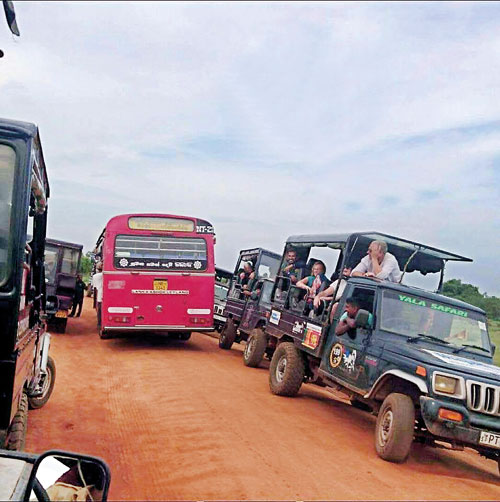
Jam-packed with vehicles – whose home is the Yala National Park?
According to her, Koh Tao’s management issues are wide-ranging – shortage of freshwater and groundwater; inadequate solid waste collection and disposal; untreated wastewater disposal from communities and tourist facilities; rapid unplanned development; construction and encroachment on beach and terrestrial forest; although building legislation and the requirement of environmental impact assessments (EIAs) are in place there is no consistent enforcement; tourist numbers exceeding the island’s carrying capacity; the uneven distribution of benefits from tourism; and the high cost of living for the local people.
The list goes on: High energy demands and dependency on diesel-fuelled generators; localized oil-spills from fishing and tourism boats; coral-reef degradation; decline in fisheries resources; and a development plan launched in 1995 but not well-adopted.
There are key factors to sustainably managing coastal tourism, says Ms. Nightingale. They are:
- Capacity development
- Consideration of a complex range of sub-national, national and transnational relationships
- Regulatory frameworks
- Community involvement, trust, acceptance and support
- Payment for Ecosystem Services (PES) – compensating for loss of earnings, protecting and restoring habitats and conserving endangered species
- Sustainable financing – entrance fees, fund-raising and private sector partnerships
- Coordination among multi-sectoral and multi-faceted agencies
- Collaboration of all stakeholders
Urging Sri Lanka not to go the way Koh Tao has gone, Ms. Nightingale added that many lessons can be learnt from this example.
BSL which organized the event is a private-sector owned and driven platform, with a membership of 63. It has been established to promote the strong engagement of the corporate sector in biodiversity and environmental conservation issues.
Meanwhile, the United Nations Development Programme (UNDP) Sri Lanka and BSL entered into a collaborative partnership, with UNDP as its first Associate Member recently.
Both organizations have identified potential areas of engagement and a set of joint activities, on areas such as policy innovation, social innovation initiatives and engagement of small and medium-sized enterprises
(SMEs). Areas such as environment sustainability and disaster resilience, tourism and biodiversity have been determined where room and potential for collaboration exists, a media release said. (Next: Focus on Sinharaja and how a hotel has turned dollars into deeds)
Source – 4/06/2017, Ther Sunday Times, See more at – http://www.sundaytimes.lk/170604/news/yala-national-park-a-mess-due-to-political-meddling-243493.html
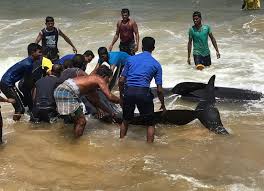
Sri Lanka saves pod of stranded whales
Colombo, Sri Lanka | AFP : Sri Lanka’s navy and local residents rescued a pod of about 20 stranded pilot whales off the island’s northeastern coast on Wednesday, an official said.
Navy spokesman Lt Commander Chaminda Walakuluge said sailors with the help of residents pushed the whales back in to deeper waters after they washed up on the Sampur coast near the port of Trincomalee.
“It was a delicate task to push them back without hurting them,” Walakuluge told AFP. “But there was a happy ending when all of them could be sent back to deeper waters.”He said it was not clear why the mammals got stranded in the area, but noted that the sea was rough due to the effects of Cyclone Mora in the Bay of Bengal and which hit Bangladesh on Tuesday.
In April 2011, a sperm whale was stranded inside the Trincomalee harbour and two navy boats were deployed to guide the mammal out into deeper waters where it was reunited with waiting whales.
Trincomalee, 260 kilometres (160 miles) northeast of Colombo, is a natural harbour and is also a popular tourist spot for whale watching.
Trincomalee is also known as the location where both of the world’s two largest mammals — elephants and whales — can be seen.
The waters around Trincomalee, which was used by Allied forces as a staging post during World War II, have a high concentration of blue and sperm whales while the surrounding jungles have herds of wild elephants.
Source – 01/06/2017,The Island , See more at – http://www.island.lk/index.php?page_cat=article-details&page=article-details&code_title=166040

